
Ceviche, cebiche, sebiche, or seviche is a dish consisting of fish or shellfish marinated in citrus and seasonings, recognized by UNESCO as an expression of Peruvian traditional cuisine and Intangible Cultural Heritage of Humanity, although different versions of ceviche are part of the culinary culture of various Spanish-American countries along the Pacific Ocean where each one is native: Chile, Colombia, Costa Rica, Ecuador, El Salvador, Guatemala, Honduras, Mexico, Nicaragua, Panama and Peru. In Peru it is also considered a flagship dish and cultural heritage.

An empanada is a type of baked or fried turnover consisting of pastry and filling, common in Spain, other Southern European countries, Latin American countries, and the Philippines. The name comes from the Spanish empanar, and translates as 'breaded', that is, wrapped or coated in bread. They are made by folding dough over a filling, which may consist of meat, cheese, tomato, corn, or other ingredients, and then cooking the resulting turnover, either by baking or frying.

The Chamorro people are the Indigenous people of the Mariana Islands, politically divided between the United States territory of Guam and the encompassing Commonwealth of the Northern Mariana Islands in Micronesia, a commonwealth of the US. Today, significant Chamorro populations also exist in several U.S. states, including Hawaii, California, Washington, Texas, Tennessee, Oregon, and Nevada, all of which together are designated as Pacific Islander Americans according to the U.S. Census. According to the 2000 Census, about 64,590 people of Chamorro ancestry live in Guam and another 19,000 live in the Northern Marianas.
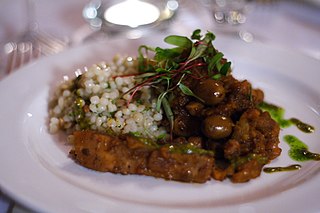
Chermoula or charmoula is a marinade and relish used in Algerian, Libyan, Moroccan and Tunisian cooking. It is traditionally used to flavor fish or seafood, but it can be used on other meats or vegetables. It is somewhat similar to the Latin American chimichurri.
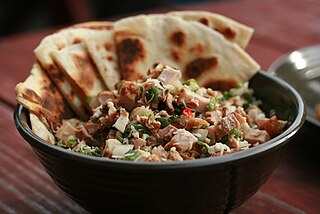
Kelaguen is a Chamorro dish from the Mariana Islands eaten as a side dish or as a main course. Similar to ceviche, a pickling marinade of lemon juice, fresh coconut, green onions, salt and spicy hot peppers or donni' is used to marinate cooked chicken, raw shrimp, fish or beef meat/liver. With the exception of the cooked chicken, the acids in the marinade "cook" the raw shrimp, fish or beef instead of heat. It is served cold or at room temperature and eaten as is, over rice, or wrapped in a warm corn or flour tortilla.
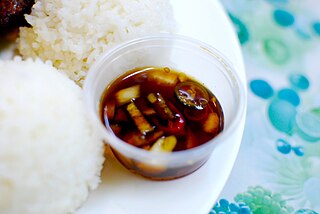
Fina'denne' is a spicy, all-purpose condiment that is a staple of Chamorro cuisine. In the Chamorro language, it translates as "made with chili pepper." It may be drizzled over meat dish or rice, or placed in a separate, small dipping saucer. Anthropologists visiting Guam in the early 20th century noted the frequent use of fina'denne' by Chamorros.

Escabeche is the name for several dishes in Spanish, Portuguese, Filipino and Latin American cuisines, consisting of marinated fish, meat or vegetables, cooked or pickled in an acidic sauce, and flavored with paprika, citrus, and other spices.

Chili sauce and chili paste are condiments prepared with chili peppers.

Tunisian cuisine, the cuisine of Tunisia, consists of the cooking traditions, ingredients, recipes and techniques developed in Tunisia since antiquity. It is mainly a blend of Mediterranean and native Punics-Berber cuisine. Historically, Tunisian cuisine witnessed influence and exchanges with many cultures and nations like Italians, Andalusians, French and Arabs.

Kinilaw is a raw seafood dish and preparation method native to the Philippines. It is sometimes also referred to as Philippine ceviche due to its similarity to the Latin American dish ceviche. It is more accurately a cooking process that relies on vinegar and acidic fruit juices to denature the ingredients, rather than a dish, as it can also be used to prepare meat and vegetables. Kinilaw dishes are usually eaten as appetizers before a meal, or as finger food with alcoholic drinks. Kinilaw is also sometimes called kilawin, especially in the northern Philippines, but the term kilawin more commonly applies to a similar lightly grilled meat dish.

The cuisine of Algeria is influenced by Algeria's interactions and exchanges with other cultures and nations over the centuries. It is based on both land and sea products. Conquests or demographic movement towards the Algerian territory were two of the main factors of exchanges between the different peoples and cultures. The Algerian cuisine is a mix of Arab, Berber, Turkish and French roots.
The Cayman Islands are a group of islands situated in the Caribbean Sea just between Cuba and Honduras. After being colonized first by Jamaica and then by the British, Cayman Islands remained under British dependency since 1962. Traditional Cayman Islands cuisine is very tied to Jamaican cuisine and they also kept British influences in their cooking, but you can as well find a large variety of international dishes with a local twist. As for traditional dishes the main ingredients are coconut, plantain, cassava, yams, rice and peas. Jamaican cuisine enriched Cayman’s cuisine by offering a large variety of spices such as jerk, curry and other exotic seasonings. The humid soil provides a large variety of exotic fruits and vegetables such as yellow squash, avocados, callaloo, cassava, calabash, spring onions, pineapples, tomatoes, peas, chili, peppers a great range of citrus fruits such as oranges, lemons, limes, grapefruits, bananas and plantains, sweet potatoes, yams and mangoes.

Balinese cuisine is a cuisine tradition of Balinese people from the volcanic island of Bali. Using a variety of spices, blended with the fresh vegetables, meat and fish. Part of Indonesian cuisine, it demonstrates indigenous traditions, as well as influences from other Indonesian regional cuisine, Chinese and Indian. The island's inhabitants are predominantly Hindu and culinary traditions are somewhat distinct with the rest of Indonesia, with festivals and religious celebrations including many special foods prepared as the offerings for the deities, as well as other dishes consumed communally during the celebrations.
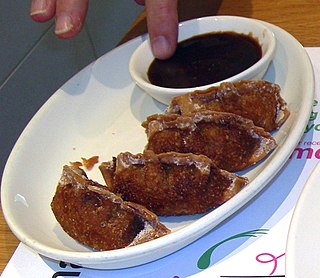
Hoisin sauce is a thick, fragrant sauce commonly used in Cantonese cuisine as a glaze for meat, an addition to stir fry, or as dipping sauce. It is dark-coloured, sweet and salty. Although regional variants exist, hoisin sauce usually includes soybeans, fennel, red chili peppers, and garlic. Vinegar, five-spice powder, and sugar are also commonly added.

Kilawin is a Filipino dish of chopped or sliced meats, poultry, seafood, or vegetables typically eaten as an appetizer before a meal, or as finger food with alcoholic drinks.
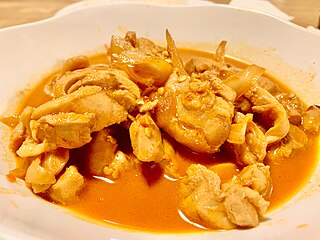
Kaddon pika is a Chamorro dish where chicken is stewed in soy sauce, vinegar, donne', garlic, and onions in one pot. It can also contain coconut milk. "Kado" refers to a protein cooked in liquid and can be soup or stew consistency. "Pika" means spicy in Chamorro. It has a savory, spicy, and sour flavor combination. The meat of a whole stewing chicken is desirable because it adds a depth of flavor that parts of fryer chicken or chicken drumettes do not have. The stewing hen meat requires a longer cooking time or a pressure cooker because it is less tender. For one stewing hen, one bulb of chopped garlic and one medium onion would be generous ratio of vegetables. It is often served with steamed rice, but can be served with vegetable dishes such as spinach, pumpkin tips, lettuce, or cabbage. Gollai hågon suni or gollai suni kalamasa could also be served with the kaddon pika. The dish can be high in sodium due to its soy sauce. The chicken skin contributes to the total saturated fat content in the dish. It is similar to chicken adobo and estufao except it contains the donne'. Although it is usually a home cooked meal, it can be found at restaurants such as King's or food stalls.

Estufao is a Chamorro dish where chunks of meat are stewed in water, vinegar, soy sauce, spices, and garlic. It is similar to Filipino adobo and kaddon pika. It is a versatile dish, so various meats such as beef, chicken, venison, or pork can be used. Thus, recipes are often different from one cook to another. Spices such as bay leaves and salt can be added. The ingredients are combined and allowed to marinate. Then, the mixture is cooked on oil until browned slightly. Water is added, and the mixture is cooked over low heat until the meat is tender. Corn starch is often added to thicken the stew. The meat and gravy can be served separated or together. The dish is often served with steamed white rice and fina'denne'.

Tinala' katne is a Chamoru dish of dried and cured beef strips similar to beef jerky from the Marianas. It is often found at parties (fiestas) and is offered by some restaurants. It tends to have a softer texture than other types of beef jerky and is more of a side dish than a snack.

PDX671, or PDX Six Seven One, was a food cart that served Guamanian cuisine in Portland, Oregon. Ed Sablan operated the business from 2010 to c. 2018 when he closed PDX671 and opened Biba CHamoru Kitchen, the city's first and only brick-and-mortar Guamanian restaurant in 2019.





















